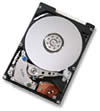Hard Drives for Notebook Computers |
Previous  Next Next |
Last Updated: December 12, 2008
Today's Best Hard Drives
 |
Owner's rated their satisfaction with these drives far above average on NewEgg. The interface, capacity and performance are the most important factors to consider. Warranty, noise and temperature are not as important. |
The table is sorted by drive capacity (GB), rotation speed (RPM), and model.
| Price | GB | $/GB | RPM | Model | Interface | Warranty |
| $75 | 320 | $0.23 | 5,400 | Western Digital Scorpio WD3200BEVT | SATA 3.0Gb/s | 3 years |
| $100 | 320 | $0.31 | 7,200 | Western Digital Scorpio Black WD3200BEKT | SATA 3.0Gb/s | 3 years |
| $115 | 500 | $0.23 | 5,400 | Western Digital Scorpio Blue WD5000BEVT | SATA 3.0Gb/s | 3 years |
Performance
Several factors contribute to the overall drive performance and rotational speed plays the most significant part. With very few exceptions, a blanket statement can be make that all 7,200rpm drives are faster than 5,400rpm drives.
Drives 160GB or larger have perpendicular sectors allowing for higher data densities. This means more data can be transferred for every rotation of the disk. This makes a 160GB, 5400rpm drive approach the speed of a 100GB, 7200rpm drive.
Beyond this, it gets a little fuzzy on which drive is faster and it really doesn't matter. Either the entire notebook computer is fast or it's slow. Photoshop loading one second faster on this drive compared to another drive isn't going to change the overall perception of the computer.
Warranty
I wouldn't trust a hard drive unless it had a 3 or 5 year warranty. A 1 year warranty doesn't speak well of a company's confidence in the drive.
Noise
The faster the rotation speed, the louder the drive. I switched from a 4,200rpm drive to a 7,200rpm drive and noticed the 7,200rpm drive was louder, but not annoying or distracting. I don't notice the hard drive noise anymore.
Temperature
The faster the rotation speed, the hotter the drive. I haven't found any reviews talking about the drive temperature, so the differences must be small enough that temperature isn't an issue.
Power Consumption
I haven't been able to find a review that compares power consumption and battery life. I suspect there isn't a big difference since the screen and wireless network card consume over half of the battery power. I'm sure there would be dozens of stories flying over the internet if a drive cut an hour off of the battery life. Tom's Hardware drive chart shows the maximum power consumption as shown:
- 4,200rpm drives take a maximum of 1.9 to 2.1 Watts.
- 5,400rpm drives take a maximum of 2.1 to 3.4 Watts.
- 7,200rpm drives take a maximum of 3.7 to 4.6 Watts.
Physical dimensions
Hard drives have 3.5 inch, 2.5 inch or 1.8 inch disks spinning inside of an enclosed metal case. Desktops use 3.5 inch disks, most notebooks use 2.5 inch disks, and only the sub 3 pound (1.4Kg) notebooks that are less than 1 inch thick use 1.8 inch disks.
Need More Hard Drive Space?
External hard drives are the fastest, easiest, and cheapest way to add more hard drive space.
Great Photos
The Tech Report has some great photos. I wish I had photos this good.